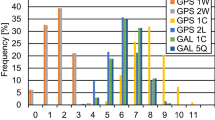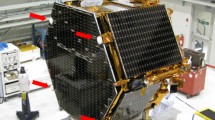Abstract
This report provides a detailed performance analysis of three semicodeless dual-frequency GPS receivers for use in low Earth orbit (LEO). The test set comprises the IGOR receiver, which represents a follow-on of the flight-proven BlackJack receiver, as well as two geodetic receivers (NovAtel OEM4-G2 and Septentrio PolaRx2), which are entirely based on commercial-off-the-shelf technology (COTS). All three receivers are considered for upcoming flight projects or experiments and have undergone at least a preliminary environmental qualification program. Using extensive signal simulator tests, the cold start signal acquisition, tracking sensitivity, differential code biases, raw measurement accuracy, and navigation accuracy of each receiver have been assessed. All tests are based on a common scenario that is representative of an actual space mission and provides a realistic simulation of the signal dynamics and quality on a scientific LEO satellite. Compared to the other receivers, the IGOR instrument exhibits a superior tracking sensitivity and is thus best suited for occultation measurements with low tangent point altitudes. The OEM4-G2 and PolaRx2 receivers are likewise shown to properly track dual-frequency GPS signals and normal signal levels and to provide accurate code and carrier phase measurements. Given their limited resource requirements, these receivers appear well suited for precise orbit determination applications and ionospheric sounding onboard of microsatellites with tight mission budgets.









Similar content being viewed by others
References
Ardaens J-S (2005) Experimental analysis of a choke ring antenna; DLR-GSOC TN 05-05. Deutsches Zentrum für Luft- und Raumfahrt, Oberpfaffenhofen
BRE (2003) Integrated GPS occultation receiver IGOR; data sheet. Broadreach Engineering, Tempe, Arizona
Buist P (2002) NEC/Toshiba Space Systems’ spaceborne GPS receivers. In: Presented at NEC/Toshiba, December 2002, Yokohama
Fenton PC, Petersen WD (1998) Dual frequency global positioning system. US Patent 5736961, April 7, 1998
Gurtner W, Estey L (2002) RINEX Version 2.20—modifications to accommodate low earth orbiter data; April 15, 2002. URL http://ftp.unibe.ch/aiub/rinex/rnx_leo.txt
Heise S, Stolle C, Schlüter S, Jakowski N (2004) Differential code bias of GPS receivers in low earth orbit: an assessment for CHAMP and SAC-C. In: Reigber CH, Lühr H, Schwintzer P, Wickert J (eds) CHAMP mission results for gravity and magnetic field mapping, and GPS atmosphere sounding. Springer, Berlin Heidelberg New York
Kroes R, Montenbruck O, Bertiger W, Visser P (2005) Precise GRACE baseline determination using GPS. GPS Solutions 9:21–31 DOI 10.1007/s10291-004-0123-5
Kursinski ER, Hajj GA, Hardy KR, Schofield JT, Linfield RP (1997) Observing Earth’s atmosphere with radio occultation measurements using the global positioning system. J Geophys Res 102/D19:23429–23465
Langley RB, Montenbruck O, Markgraf M, Kang CS, Kim D (2004) Qualification of a commercial dual-frequency GPS receiver for the e-POP platform onboard the Canadian CASSIOPE spacecraft. In: Second ESA workshop on satellite navigation user equipment technologies, NAVITEC’2004, December 8–10, 2004, Noordwijk, The Netherlands
Lear WM (1987) GPS navigation for low-earth orbiting vehicles; NASA 87-FM-2, Rev. 1; JSC-32031, Lyndon B. Johnson Space Center, Houston
Leyssens J, Markgraf M (2005) Evaluation of a commercial-off-the-shelf dual-frequency GPS receiver for use on LEO satellites. In: ION GNSS 2005 conference, September 13–16, 2005, Long Beach, California
Markgraf M, Montenbruck O (2004) Total ionizing dose testing of the NovAtel OEM4-G2L GPS receiver; DLR-GSOC TN 04-04. Deutsches Zentrum für Luft- und Raumfahrt, Oberpfaffenhofen
Marradi L, Banfi E, Mambretti A (2001) The Lagrange receiver: design and in-flight demonstration. NAVITECH’2001, December 10–12, 2001, Noordwijk
Meehan TK, Thomas JB Jr, Young LE (2000) P-code enhanced method for processing encrypted GPS signals without knowledge of the encryption code. US Patent 6061390, May 9, 2000
Montenbruck O, Holt G (2002) Spaceborne GPS receiver performance testing; DLR-GSOC TN 02-04. Deutsches Zentrum für Luft- und Raumfahrt, Oberpfaffenhofen
Montenbruck O, Kroes R (2003) In-flight performance analysis of the CHAMP BlackJack receiver. GPS Solut 7:74–86
Montenbruck O, van Helleputte T, Kroes R, Gill E (2005) Reduced dynamic orbit determination using GPS code and carrier measurements. Aerospace Sci Technol 9/3:261–271 DOI 10.1016/j.ast.2005.01.003
Rankin D, Kekez DD, Zee RE, Pranajaya FM, Foisy DG, Beattie AM (2004) The CanX-2 nanosatellite: expanding the science abilities of nanosatellites. In: Proceedings of the 55th International Astronautical Congress, October 2004, Vancouver, Canada
Reigber CH, Jochmann H, Wünsch J, Petrovic S, Schwintzer P, Barthelmes F, Neumayer K-H, König R, Förste CH, Balmino G, Biancale R, Lemoine J-M, Loyer S, Perosanz F (2004) Earth gravity field and seasonal variability from CHAMP. In: Reigber CH, Lühr H, Schwintzer P, Wickert J (eds) Earth observation with CHAMP—results from three years in orbit. Springer, Berlin Heidelberg New York, pp 25–30
Silvestrin P, Cooper J (2000) Method of processing of signals of a satellite positioning system. US Patent 6157341, December 5, 2000
Silvestrin P, Bagge R, Bonnedal M, Carlström A, Christensen J, Hägg M, Lindgren T, Zangerl F (2000) Spaceborne GNSS radio occultation instrumentation for operational applications. In: ION-GPS-2000 conference, Salt Lake City, September 19–22, 2000, pp 872–880
Spirent (2004) SimGEN (including SimLocate) user manual—software for the Spirent range of satellite navigation simulator products; DGP00686AAA; Issue 1–13, August 2004
Thomas JB (1995) Signal-processing theory for the TurboRogue receiver. JPL Publication 95–6, April 1, 1995
Van Dierendonck AJ (1995) GPS receivers. In: Spilker J, Parkinson B (eds) Global positioning system: theory and applications, vol I, chapt. 8. American Institute of Aeronautics and Astronautics Inc., Washington
Williams J, Lightsey EG, Yoon SP, Schutz RE (2002) Testing of the ICESat BlackJack GPS receiver engineering model. In: ION-GPS-2002 conference, September 24–27, 2002, Portland, Oregon
Woo KT (2000) Optimum semi-codeless carrier phase tracking of L2. Navigation: J Inst Navigation 47(2):82
Wu B-H, Chu V, Chen P, Ting TH (2005) FORMOSAT-3/COSMIC science mission update. GPS Solut 9:111–121
Yunck TP (2004) Spaceborne GPS for POD and earth science. In: Reigber CH, Lühr H, Schwintzer P, Wickert J (eds) Earth observation with CHAMP— results from three years in orbit. Springer, Berlin Heidelberg New York, pp 25–30
Acknowledgments
Testing of the IGOR flight unit for the TerraSAR-X project has been enabled through the GeoForschungsZentrum, Potsdam, which also provided an engineering model of the CHAMP choke ring antenna for ground verification. Prof. E.G. Lightsey, Center for Space Research of the University of Texas at Austin, and Prof. Ch. Günther, Institute of Communications and Navigation of the German Aerospace Center (DLR), have kindly provided access to their Spirent GPS signal simulators. OEM4-G2 and PolaRx2 receivers with deactivated altitude and speed limitations have been provided by NovAtel, Canada, and Septentrio, Belgium, with permission of local governmental authorities. The authors gratefully acknowledge the support of all institutions and individuals, which have been vital for a successful performance of the present study.
Author information
Authors and Affiliations
Corresponding author
Rights and permissions
About this article
Cite this article
Montenbruck, O., Garcia-Fernandez, M. & Williams, J. Performance comparison of semicodeless GPS receivers for LEO satellites. GPS Solut 10, 249–261 (2006). https://doi.org/10.1007/s10291-006-0025-9
Received:
Published:
Issue Date:
DOI: https://doi.org/10.1007/s10291-006-0025-9




